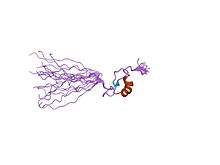(Redirected from MYND-type )
Protein family
In molecular biology the MYND-type zinc finger domain is a conserved protein domain . The MYND domain (my eloid, N ervy, and D EAF-1) is present in a large group of proteins that includes RP-8 (PDCD2 ), Nervy , and predicted proteins from Drosophila , mammals , Caenorhabditis elegans yeast , and plants . The MYND domain consists of a cluster of cysteine and histidine residues, arranged with an invariant spacing to form a potential zinc-binding motif . Mutating conserved cysteine residues in the DEAF-1 MYND domain does not abolish DNA binding, which suggests that the MYND domain might be involved in protein-protein interactions . Indeed, the MYND domain of ETO/MTG8 interacts directly with the N-CoR and SMRT co-repressors . Aberrant recruitment of co-repressor complexes and inappropriate transcriptional repression is believed to be a general mechanism of leukemogenesis caused by the t(8;21) translocations that fuse ETO with the acute myelogenous leukemia 1 (AML1 ) protein. ETO has been shown to be a co-repressor recruited by the promyelocytic leukemia zinc finger (PLZF ) protein. A divergent MYND domain present in the adenovirus E1A binding protein BS69 was also shown to interact with N-CoR and mediate transcriptional repression . The current evidence suggests that the MYND motif in mammalian proteins constitutes a protein-protein interaction domain that functions as a co-repressor-recruiting interface.
References
Feinstein PG, Kornfeld K, Hogness DS, Mann RS (June 1995). "Identification of homeotic target genes in Drosophila melanogaster including nervy, a proto-oncogene homologue" . Genetics . 140 (2): 573–86. doi :10.1093/genetics/140.2.573 . PMC 1206636 . PMID 7498738 .
^ Gross CT, McGinnis W (April 1996). "DEAF-1, a novel protein that binds an essential region in a Deformed response element" . EMBO J . 15 (8): 1961–70. doi :10.1002/j.1460-2075.1996.tb00547.x . PMC 450115 . PMID 8617243 .
Owens GP, Hahn WE, Cohen JJ (August 1991). "Identification of mRNAs associated with programmed cell death in immature thymocytes" . Mol. Cell. Biol . 11 (8): 4177–88. doi :10.1128/MCB.11.8.4177 . PMC 361239 . PMID 2072913 .
Lutterbach B, Sun D, Schuetz J, Hiebert SW (June 1998). "The MYND motif is required for repression of basal transcription from the multidrug resistance 1 promoter by the t(8;21) fusion protein" . Mol. Cell. Biol . 18 (6): 3604–11. doi :10.1128/MCB.18.6.3604 . PMC 108942 . PMID 9584201 .
Lutterbach B, Westendorf JJ, Linggi B, Patten A, Moniwa M, Davie JR, Huynh KD, Bardwell VJ, Lavinsky RM, Rosenfeld MG, Glass C, Seto E, Hiebert SW (December 1998). "ETO, a target of t(8;21) in acute leukemia, interacts with the N-CoR and mSin3 corepressors" . Mol. Cell. Biol . 18 (12): 7176–84. doi :10.1128/MCB.18.12.7176 . PMC 109299 . PMID 9819404 .
Melnick AM, Westendorf JJ, Polinger A, Carlile GW, Arai S, Ball HJ, Lutterbach B, Hiebert SW, Licht JD (March 2000). "The ETO protein disrupted in t(8;21)-associated acute myeloid leukemia is a corepressor for the promyelocytic leukemia zinc finger protein" . Mol. Cell. Biol . 20 (6): 2075–86. doi :10.1128/MCB.20.6.2075-2086.2000 . PMC 110824 . PMID 10688654 .
Masselink H, Bernards R (March 2000). "The adenovirus E1A binding protein BS69 is a corepressor of transcription through recruitment of N-CoR" . Oncogene . 19 (12): 1538–46. doi :10.1038/sj.onc.1203421 . PMID 10734313 .
External links
This article incorporates text from the public domain Pfam and InterPro : IPR002893
Category :
Text is available under the Creative Commons Attribution-ShareAlike License. Additional terms may apply.
**DISCLAIMER** We are not affiliated with Wikipedia, and Cloudflare.
The information presented on this site is for general informational purposes only and does not constitute medical advice.
You should always have a personal consultation with a healthcare professional before making changes to your diet, medication, or exercise routine.
AI helps with the correspondence in our chat.
We participate in an affiliate program. If you buy something through a link, we may earn a commission 💕
↑
 solution structure of zf-mynd domain of protein cbfa2ti (protein mtg8)
solution structure of zf-mynd domain of protein cbfa2ti (protein mtg8)